The oedema is normally not a decease, more a cultural thing. Mostly it disappear after a while. So with whitening of leaves, sometimes my phrags show this behaviour, likely to be an intermittent deficiency. Might have to do with insufficiently developed roots when growt flush commences?
You are using an out of date browser. It may not display this or other websites correctly.
You should upgrade or use an alternative browser.
You should upgrade or use an alternative browser.
Erwinia or minor infection?
- Thread starter Kostas
- Start date

Help Support Slippertalk Orchid Forum:
This site may earn a commission from merchant affiliate
links, including eBay, Amazon, and others.
Kostas
Well-Known Member
Thank you very much for your reply Bjorn, i appreciate it! Great to hear the translucent/watersoaked appearing areas on the leafs are not caused by a pathogen and that they disappear after a while! I was actually searching today for some of the ones i photographed and couldn't find them on the leafs, which was a relief. I did find some but many i didn't. What seems to causes it from your experience?
Good to know the whitening isn't associated with a dying leaf only but with a deficiency. The plant appears well rooted but i have not repotted it and can only guess on its roots from what i see.
Its doing quite well now and growing fast with daily watering, so hopefully it will get beautiful again in a few months and maybe i see a flower within a year
Good to know the whitening isn't associated with a dying leaf only but with a deficiency. The plant appears well rooted but i have not repotted it and can only guess on its roots from what i see.
Its doing quite well now and growing fast with daily watering, so hopefully it will get beautiful again in a few months and maybe i see a flower within a year
Kostas
Well-Known Member

Shall I removed the 2 oldest leafs of the left growth or wait them out to dry more? I don't like the succulent/wet browning that is starting to develop at their still live leaf bases. Both leafs are dead and have dried nicely, and i am waiting them to fully dry before removal for no open wounds and nutrient relocation. But I think this browning is too close to the base now and may spread before they dry. Would you leave or remove now? I also don't like the wet brown marks seen on the edge of the third oldest leaf. That leaf is also slowly dying and drying but the lower half of it is still green(the plant was severly water stressed from the transport and this leaf was apparently much affected too, arriving half yellow, so i think it will dehisce soon). I am thinking of waiting that out but maybe remove the 2 oldest. I think it shouldn't compromise the structure of the plant but I don't like leaving them thin at the base, so let me know what you think
The oldest scale leaf of the right growth is now fully dry and will remove it today.
This is what I would do...
Cut the brown leaves off about 1 inch above the base.
The split apart lengthwise the remaining leave stubs down to the base, but dont pull them off.
That will allow air to get in around the base of the green leaves and still not create any wound in he other leaves. Then later after the stubs are all dried up remove the.
Cut the brown leaves off about 1 inch above the base.
The split apart lengthwise the remaining leave stubs down to the base, but dont pull them off.
That will allow air to get in around the base of the green leaves and still not create any wound in he other leaves. Then later after the stubs are all dried up remove the.
Kostas
Well-Known Member
Thank you Lance!
I removed the oldest leaf as the wet looking browning was very close to the base(does this damage/wound the stem or do the leafs pull off where they would naturally dehisce if left to dry, thus not wounding the trunk or taking with them stem tissues they shouldn't?)
The other leafs are still ok at the base, so I am leaving be for now
Any idea what these surface yellow marks are from? They seem like spider mites but not quite. Maybe dried up plant excrements(from when that leaf was still developing)?
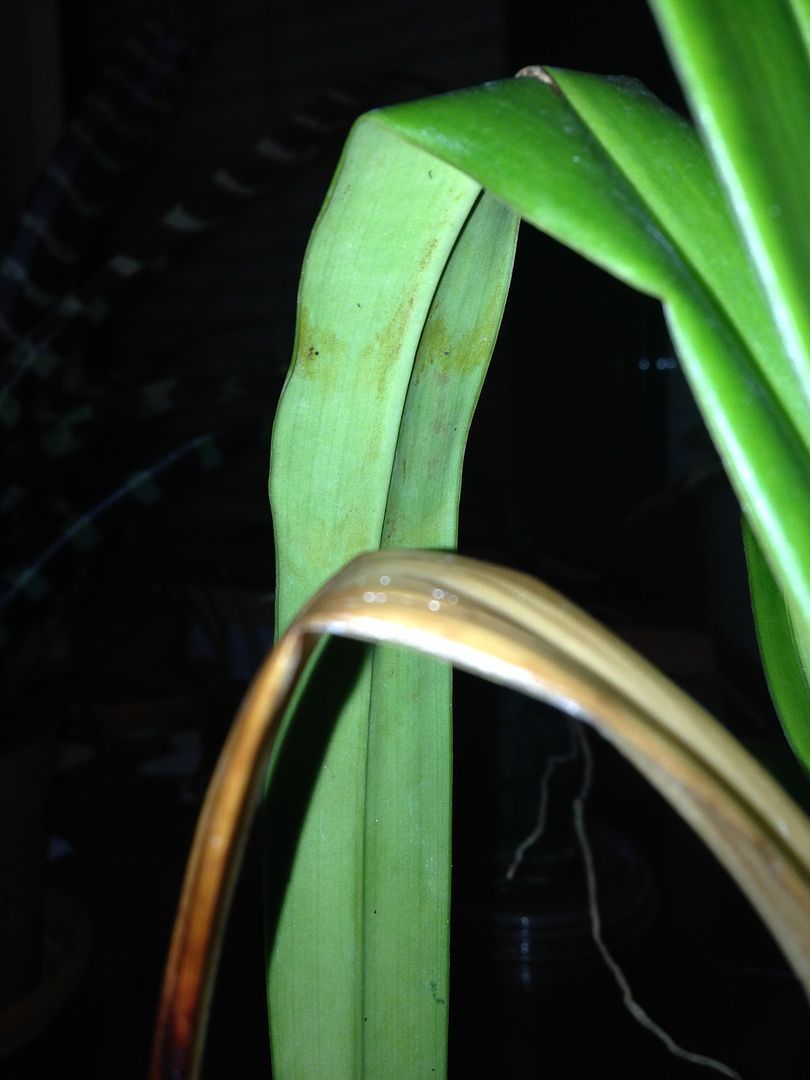
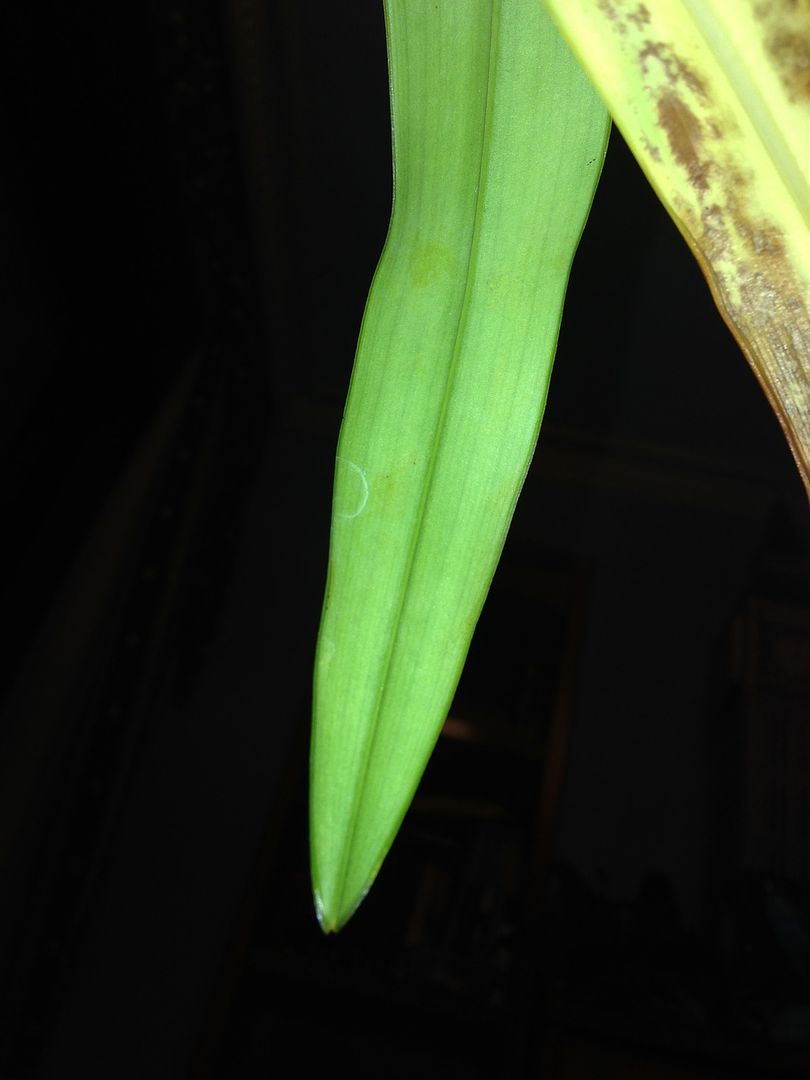
I removed the oldest leaf as the wet looking browning was very close to the base(does this damage/wound the stem or do the leafs pull off where they would naturally dehisce if left to dry, thus not wounding the trunk or taking with them stem tissues they shouldn't?)
The other leafs are still ok at the base, so I am leaving be for now
Any idea what these surface yellow marks are from? They seem like spider mites but not quite. Maybe dried up plant excrements(from when that leaf was still developing)?


Thank you Lance!
I removed the oldest leaf as the wet looking browning was very close to the base(does this damage/wound the stem or do the leafs pull off where they would naturally dehisce if left to dry, thus not wounding the trunk or taking with them stem tissues they shouldn't?)
When you remove a leaf before it is ready to go, sometimes it comes clean at the normal dehisce point and sometimes it doesn't. When it doesn't it can cause some damage to the remaining leaf bases. On a healthy plant that damage is no problem but if you suspect there might be some pathogen present it's safest to do as I described above.
Sometimes if there is a potential rot problem it is good to split the leaf stub base that is below the dehisce point to let air in to help dry it up (sometimes).
The other leafs are still ok at the base, so I am leaving be for now
Give it some time.
Any idea what these surface yellow marks are from? They seem like spider mites but not quite. Maybe dried up plant excrements(from when that leaf was still developing)?
The yellow marks look like they might be a stain from when that point of the leaf was emerging from the base as the leaf grew. Notice how the pattern is basically the same shape on each side of the midrib. That indicates the stain happened when the leaf was still folded and the color happened at the point when the tender underside of the leaf was in contact to the older leaf below, air, and surface water.

$6.99 ($2.33 / Fl Oz)
Bolero Revive Facial Moisturizer - Wild Orchid & Tea Tree 3fl oz (88.7ml)
Halo's Items Store

$52.00 ($52.00 / Fl Oz)
Magnolia Orchid Aloe Enzyme Facial Exfoliator for All Skin Types, 17 Fl Oz/500 mL
Home Destination

$23.18 ($6.82 / Fl Oz)
$26.57 ($7.81 / Fl Oz)
Vera Wang Princess Eau de Toilette Spray for Women, Vanilla, 3.4 Fl Ounce
Amazon.com

$14.99 ($5.00 / Count)
$15.99 ($5.33 / Count)
Mkono 3 Pack Self Watering Planter African Violet Pots Plastic White Flower Plant Pot with Wick Rope for All House Plants, Flowers, Herbs, Medium
Mkono

$11.99 ($0.12 / Count)
CHUXAY GARDEN Cypripedioideae-Lady's Slipper Orchids,Lady Slipper Orchids 100 Seeds Tropical Exotic Orchids Rare Small Orchid
color green

$50.00 ($5.88 / Fl Oz)
Magnolia Orchid Collagen Age Signature Jelly Mask for All Skin Types, 8.5 Fl Oz/250 ml
BBCV

$45.98 ($45.98 / Count)
$49.89 ($49.89 / Count)
hypehouse Allen + roth 8 in. Orchid Pot with Saucer White
Soko One

$25.49
$44.00
Understanding Orchids: An Uncomplicated Guide to Growing the World's Most Exotic Plants
Amazon.com

$16.98
$19.98
Nlife Bring On The Sunshine Graphic Short Sleeves Tees Blouses for Women Tops Sweaters for Women
waltzmart

$19.99
$48.00
Gloria Vanderbilt Women's Amanda Classic High Rise Tapered Jean, Black, 14 Regular
Amazon.com

$16.13
$22.95
The Orchid Whisperer: Expert Secrets for Growing Beautiful Orchids (-)
Amazon.com
Kostas
Well-Known Member
How can it damage the remaining leaf bases? I can see how it could cause some stem damage or scarring but don't know how it could damage the leafs above it.
I think the ones i have removed so far have come relatively clean but the leaf bases on this kovachii are very fibrous and the fibres don't break, so i left the ones that wouldn't break in order not to cause any damage. My other kovachii has leaf bases without such strong fibres
I have split the leaf base of the other brown leaf that had some slight rot towards the base but haven't removed it. Hope it fully dries soon and can be removed. One more dying leaf left and i think i am done with the drought stress damaged leafs. Its growing well, so i look forward to seeing it fully replace its canopy and be beautiful
Yes, i noticed the identical shape and thought exactly the same. So i guess its nothing to worry about.
I think the ones i have removed so far have come relatively clean but the leaf bases on this kovachii are very fibrous and the fibres don't break, so i left the ones that wouldn't break in order not to cause any damage. My other kovachii has leaf bases without such strong fibres
I have split the leaf base of the other brown leaf that had some slight rot towards the base but haven't removed it. Hope it fully dries soon and can be removed. One more dying leaf left and i think i am done with the drought stress damaged leafs. Its growing well, so i look forward to seeing it fully replace its canopy and be beautiful
Yes, i noticed the identical shape and thought exactly the same. So i guess its nothing to worry about.
How can it damage the remaining leaf bases? I can see how it could cause some stem damage or scarring but don't know how it could damage the leafs above it.
I think the ones i have removed so far have come relatively clean but the leaf bases on this kovachii are very fibrous and the fibres don't break, so i left the ones that wouldn't break in order not to cause any damage. My other kovachii has leaf bases without such strong fibres
It's actually the tearing fibers that can peel away tissue past the base of the leaf if you keep pulling and they don't break. That tearing of the lower tissue is what I meant y damage to the base of other leaves.
Kostas
Well-Known Member
I get what you mean now. I have always been wary not to pull on fibres that don't break clean easily as i grow palms and i have seen what pulling on them can do by photos from other growers. That can happen with both green and brown leafs if they are not ready. I go easy on them...
Kostas
Well-Known Member
Looks like it's one more leaf to go and it's done with the drought damage from the shipping
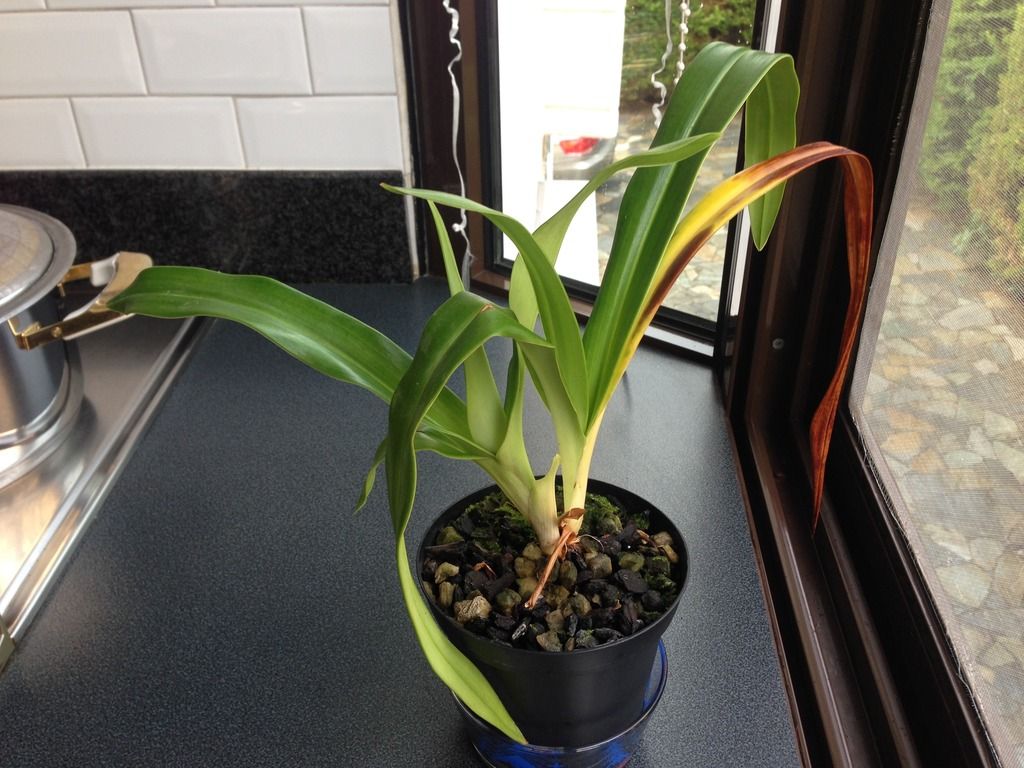
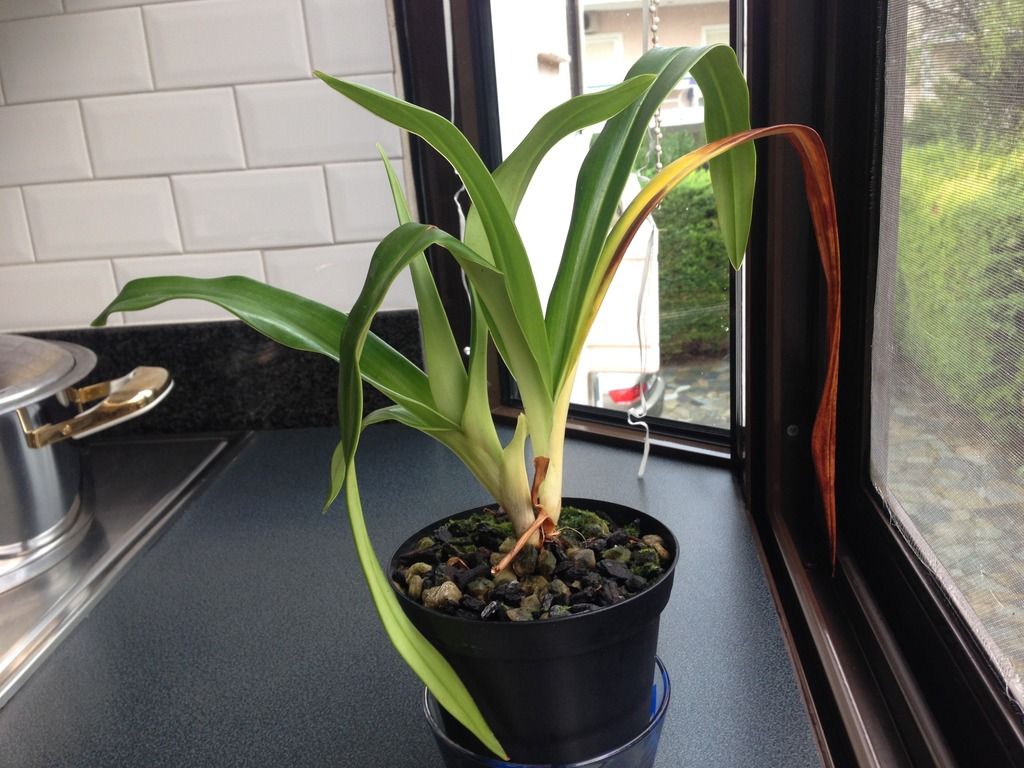
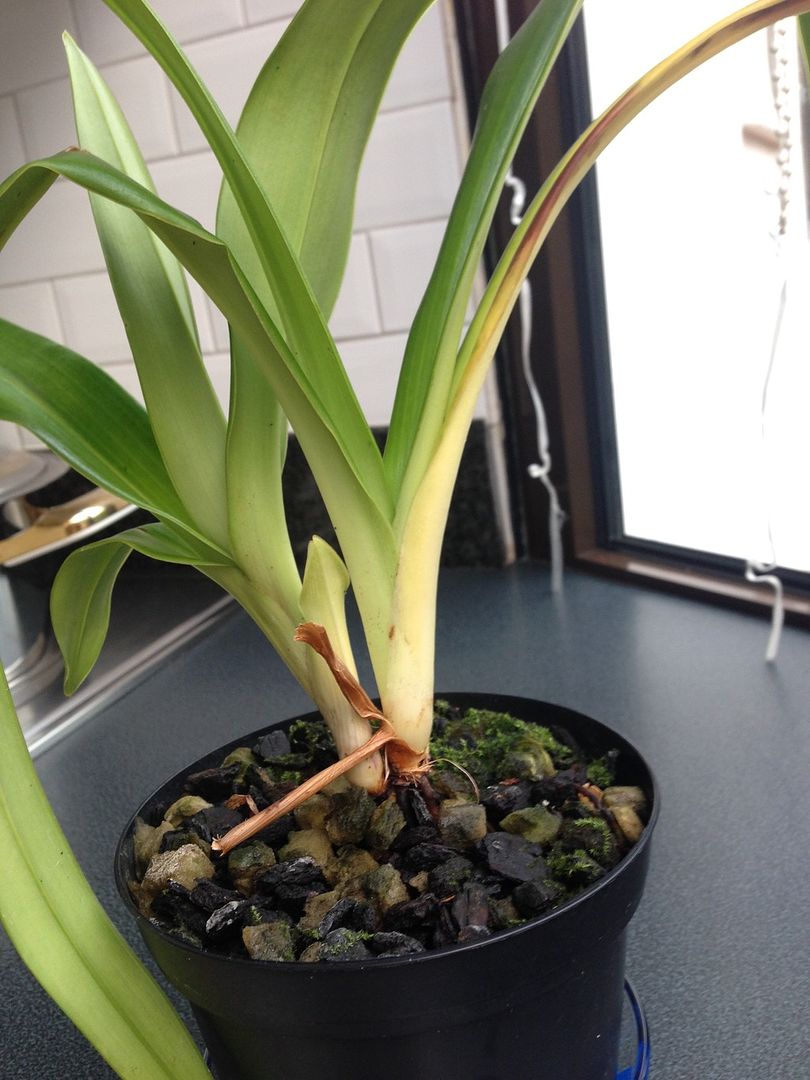
Fortunately they are growing well and fast.
Why are the motherplants so much stunted in kovachii compared to their pups? I always see the original motherplant grown from seed to be punny/with strange and slower growth habits compared to the pups. Both the pup and the motherplant are growing for me but the pup is faster so far



Fortunately they are growing well and fast.
Why are the motherplants so much stunted in kovachii compared to their pups? I always see the original motherplant grown from seed to be punny/with strange and slower growth habits compared to the pups. Both the pup and the motherplant are growing for me but the pup is faster so far
Why are the motherplants so much stunted in kovachii compared to their pups? I always see the original motherplant grown from seed to be punny/with strange and slower growth habits compared to the pups. Both the pup and the motherplant are growing for me but the pup is faster so far
Because the pups have more support as the plant gets older so each growth can be bigger aand stronger than the previous...until the plant reaches maturity.
Also kovachii does not like to keep older growths, they usually fade away as the new growths take over.
Kostas
Well-Known Member
So a big older growth can waste away without ever flowering, just because it grew a pup? The older growth of this one keeps growing, just slower. Is it bound to stop growth and waste away or should it eventually flower?
So a big older growth can waste away without ever flowering, just because it grew a pup? The older growth of this one keeps growing, just slower. Is it bound to stop growth and waste away or should it eventually flower?
Probably wont flower, usually the spike forms just as the growth is finished growing leaves. The growths have to meet a certain time frame of age to reach sexual maturity to flower. Just because a growth is big enough to flower does not mean it is old enough. Let me clarify that... the plant as a whole has to reach a certain age to mature, not each individual growth. The plant may need to be 4 years old to bloom but no single growth on the plant has been there for 4 years, but the base/rhizome has been.
Kostas
Well-Known Member
I understand. I think this one is both old enough and big enough to flower within 1 year. If the old growth won't flower, then what will it do? Just stop growing and go leafless eventually?
I understand. I think this one is both old enough and big enough to flower within 1 year. If the old growth won't flower, then what will it do? Just stop growing and go leafless eventually?
The old growth will produce and support the new growth. When well grown the growths on a near mature kovachii can produce as many as 5 new growths! Suddenly the plant can get big. But as you suspect the old growth you have now will begin to loose its leaves and disappear. But that just makes room for the new growths to occupy the space. The old growth built the foundation for the mature plant. So after the new growth starts to get some size don't panic when you see the old growth start to "die". It's not dying, it's just shedding much like little limbs do on a tree trunk as the tree grows.
Kostas
Well-Known Member
Thank you Lance! That helps a lot to know 
Similar threads
- Replies
- 3
- Views
- 1K
- Replies
- 1
- Views
- 506
- Replies
- 4
- Views
- 2K
- Replies
- 14
- Views
- 3K



































